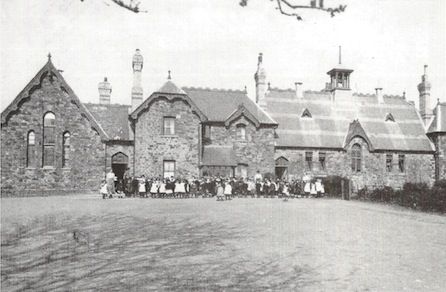Prendergast School
15th July 2015

The Old School
Two weeks ago, an article relevant to Prendergast was submitted by David Redd and Dai Griffiths both of whom are helping me to put together a walk through the area for Haverfordwest Civic Society on the 17th of this month. As such, I wanted to whet your appetite a little further and give some detail about a building, once integral to Prendergast and indeed to the rest of Haverfordwest.
Prendergast Primary School was a Victorian gothic dream. A truly beautiful edifice which of course you don’t recognise whilst a pupil...which I was for six or seven years (quite a long time ago...I’m not saying when).
The concept of new schools, not only in Pembrokeshire but across the country came as a result of the government becoming aware that countries that did well in war invariably had better educational systems in place than those that were defeated, most notably, the northern states during the American Civil War.
And so, the 1870 Education Act was the first specific piece of legislation to address education. In 1872 the architect D E Thomas, submitted plans for the building of a new primary school. He came second and was awarded a compensatory prize of £5. The winner was T P Reynolds, also an architect in the town. The resulting school was a masterpiece of Victorian gothic architecture that was to serve the function for which it was created until 2010.
The School opened in 1874 and was the only primary school in the town outside of the parish of St Martins. At a time when church and non conformist educational rivalries were at their height, Prendergast opted to become a member of the School Board and thus secured both state finance and essentially, financial support from the local rates. The church vigorously resisted and opposed a School Board on the grounds of those becoming members not being in control of their own curriculum which for the church schools was almost entirely religious. Those church schools that remained outside the School Board (such as Haverfordwest VC School) were obliged to depend on voluntary contributions...with disastrous results.
Compulsory education was introduced in 1876 – but was still not free, making matters worse. On the 25th July 1879 John Jenkins of Haverfordwest was prosecuted for not sending his three children to school. In court, his wife said that eight people lived off her husband’s wage of eight shillings per week and she could not afford boots for her children let alone pay for their schooling.
Finally in 1891, education became free. In 1902 Local Education Authorities replaced School Boards and took control of the curriculum.
In 1904 Waldo Williams was born in Prendergast School House. His father was at the time, a master of the school, before moving with his family to the more northerly and Welsh parts of the county. Waldo went on to become known as a Welsh language poet, a fanatical pacifist and a Quaker.
In March 1938 the Western Mail set a national (Wales) competition for an essay to be written by pupils in their final year of primary school (age eleven) and I’m very proud to tell you that my late mother Marguerite Gambold, a pupil of Prendergast Primary School, won. She was presented with a diploma and a small cheque by the Director of Education, the chairman of the Board of Education and host of other dignitaries. It is only recently that I examined the tile of the essay which was, ‘How to Beautify my Town’. It’s quite touching really, as a considerable number of groups are still trying to do the same thing 77 years later. The photograph shows her receiving her cheque etc outside the door on the far left of the school. Her father, my grandfather, disabled from wounds received in the 1st World war stands on the left.

Marguerite Gambold receiving a prize from a host of dignitaries
In 2010 the school moved to its new premises in Stokes Avenue. Almost immediately began the demolition of the old school. I ventured on to the demolition site several times and was told by the demolition firm that the old building was far stronger than had been anticipated. The new Archive Building was opened in March 2013 and took over from the old site in Haverfordwest Castle.